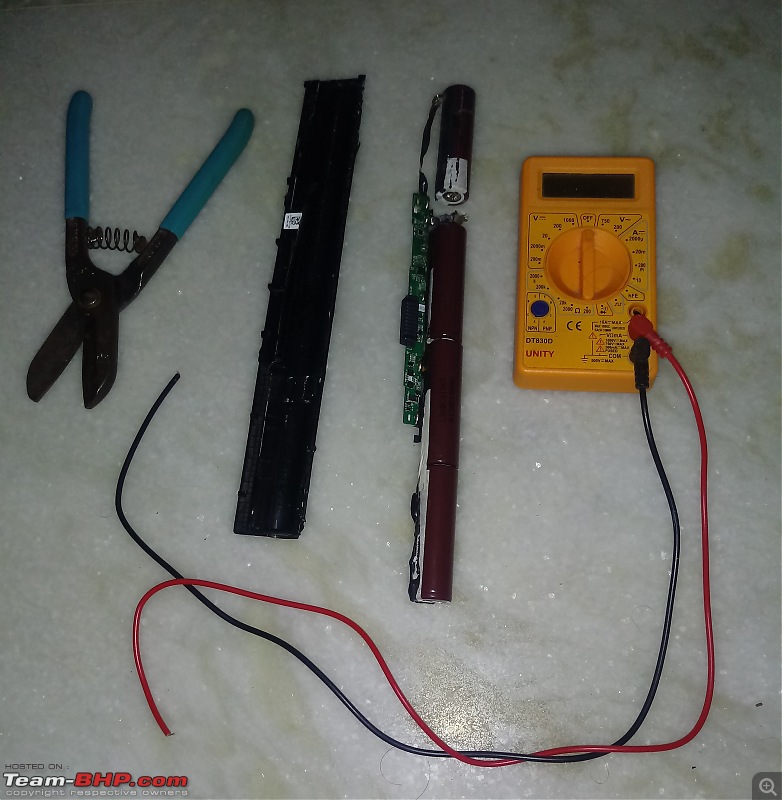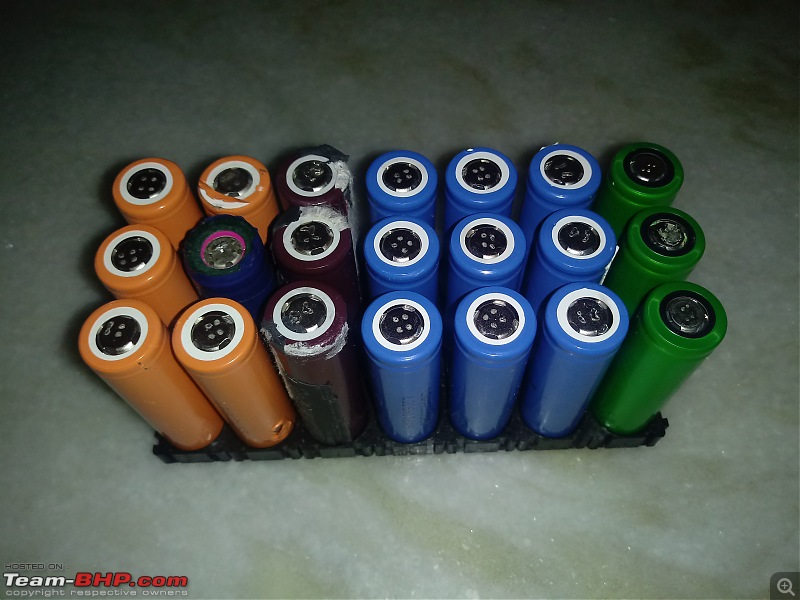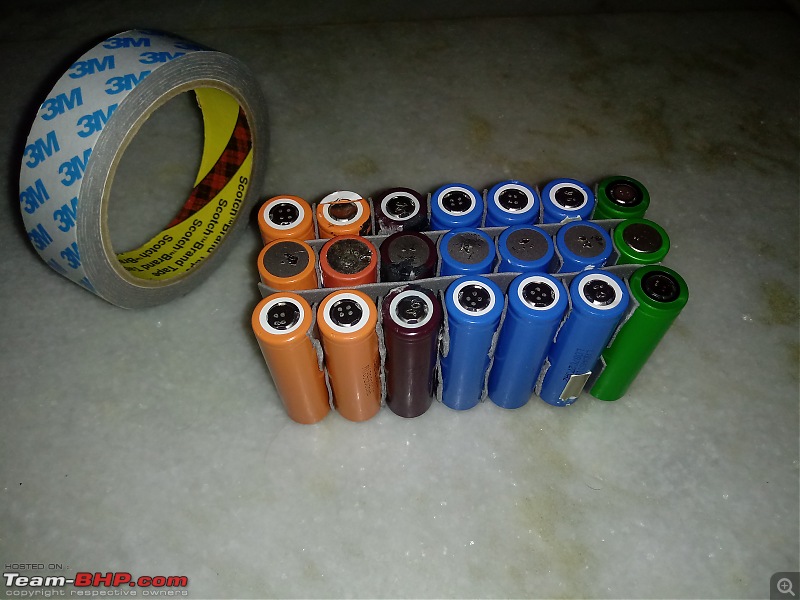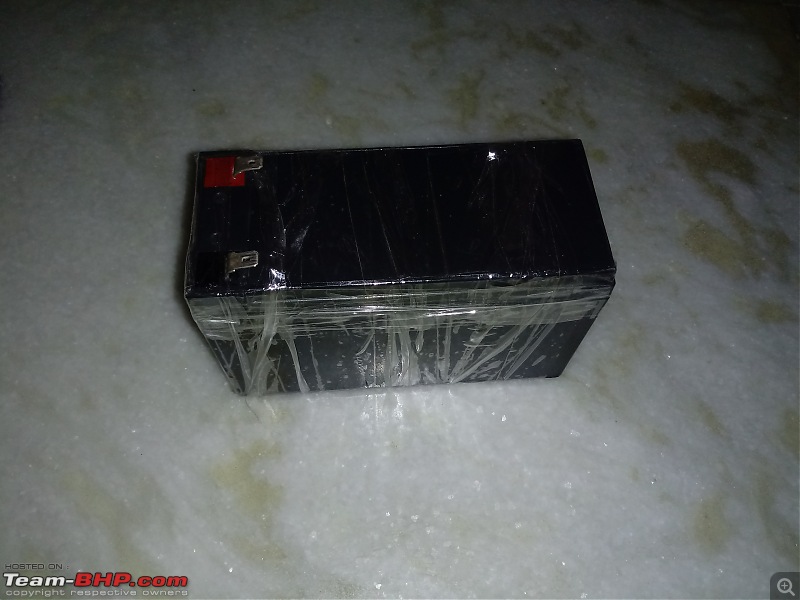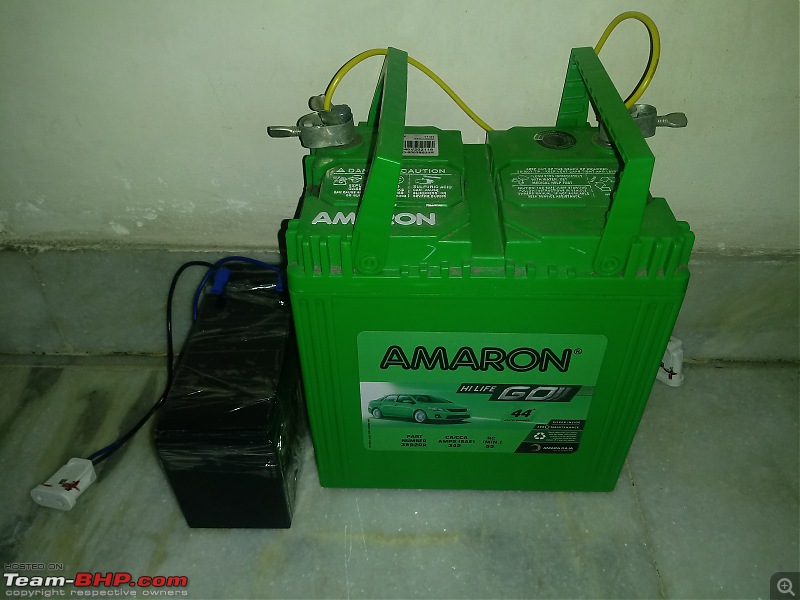| |||||||
| Search Forums |
| Advanced Search |
| Go to Page... |
 |
| Search this Thread |  48,195 views |
| | #1 |
| BHPian Join Date: Jun 2019 Location: Kolkata
Posts: 395
Thanked: 2,855 Times
| DIY: Making a DIY 12v Lithium-Ion battery at home Making a DIY 12v Lithium-ion battery at home Here is how my son made a 12v Lithium-ion battery but first a little background information. We had a 6 year old UPS (Uninterruptible Power Supply) battery of capacity 7.5 Ah that had died twice in the past and had been refurbished twice with some fresh battery acid solution. We had been using that battery for the past 2 years as a solar battery (with a 50 watt solar panel) for running a small fan (6-7 watts), a small dimmed light (3.5 watts) and the occasional charging of USB devices. That battery weighed approximately 2.25 kilograms. Recently, that battery started showing signs of dying again. As a result, we decided that we have had enough and wanted to upgrade to a lithium battery. And since the prices of lithium battery packs are exorbitant (relatively speaking), my son decided to make one by himself again using salvaged cells from dead laptop computer battery packs. For that, he drew heavily from the experience gained during an earlier DIY project involving the making of a portable power station (link below). https://www.team-bhp.com/forum/diy-d...r-station.html (DIY: Portable Lithium Power Station) Hence, for fear of being repetitive, this thread will be a largely pictorial account. So put your seatbelts on, grab a snack, grab a drink and let us begin. Firstly, we needed to determine how many 18650 model cells could be installed in a 3S (3 cells in series) configuration inside the lead-acid battery's case. In our instance, we found that we could install exactly 21 such cells inside the case while accounting for the battery management system (BMS) printed circuit board (PCB) as well. The image below shows the 3 cells in perfectly fine working condition that my son managed to salvage from his own laptop computer's dead battery pack. Similar to the ones above, my son managed to salvage more cells from dead battery packs of laptop computers that he purchased from computer repair shops near our location. Here are the details of the cells from left to right in the image above that we found online as follows :- 1) The first 6 cells with the orange wrapper. 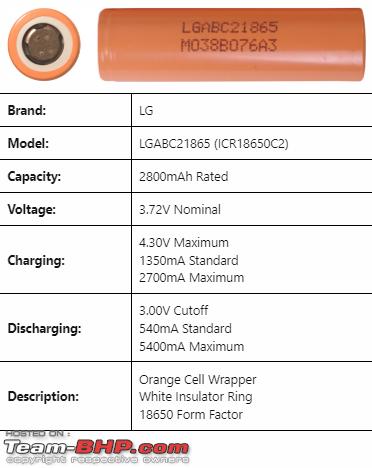 2) The next 3 cells with the brown wrapper 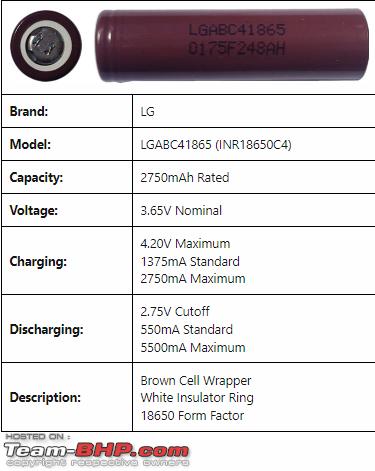 3) The next 6 cells with the blue wrapper. 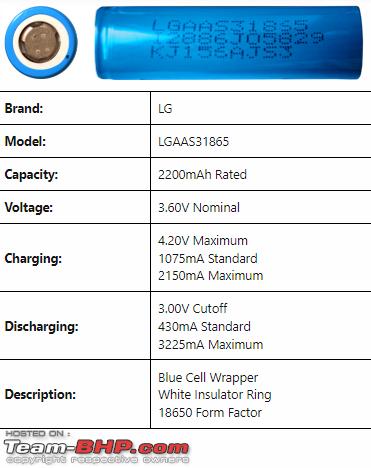 4) The next 3 cells with the blue wrapper. 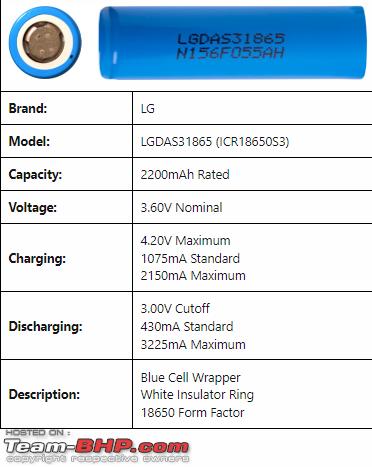 5) The final 3 cells with the green wrapper. 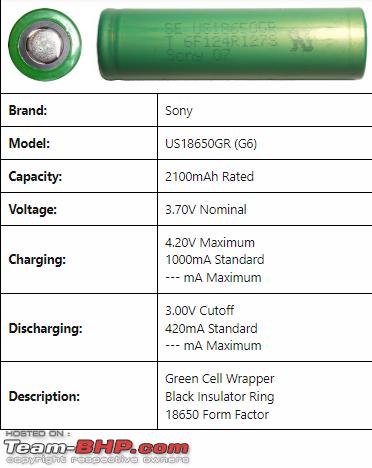 However, we could not fit the cells inside the case if we used the plastic spacers and hence we had to go ahead without the spacers. On the other hand, we still needed to find a way to keep the cells physically separated from each other to prevent thermal runaway so that even if one cell overheats then the remaining ones would remain unaffected up to an extent. But we had to somehow hold the cells together as well and hence we decided to go for some double-sided adhesive tape. Then the cells were bound by some polyimide adhesive tape aka Kapton tape and 18650 ring insulators made of barley paper were attached around the positive terminals of the cells. After that nickel-plated strips with a cross-sectional area of 7 mm x 0.15 mm were spot welded to the cells in such a way as to make a 3S7P (3 cells in series 7 cells in parallel) battery pack as you can see in the image below. Finally, after coating the 6 terminals of the BMS with some melted soldering wire, we attached two small wires of 1 square millimetre cross-sectional area to the main input/output terminals of the BMS. Sadly, we could not find a black coloured wire for the negative terminal and had to make do with the red wire. Then the BMS was attached to one of the smaller sides of the battery pack (using a double layer of double-sided adhesive tape) corresponding to the cell voltages of the battery pack. The remaining terminals were spot welded to the nickel-plated strips of the 3S7P battery pack as per the voltages and/or polarities. The unnecessary portions/terminals of the nickel-plated strips were obviously cut off from the battery pack before the spot welding. Then the battery pack was covered completely with polyimide adhesive tape. Here it is important to note that we could have easily gone for a 20 ampere BMS but we went for the 40 ampere one to maintain some scope for capacity upgrades in the future if necessary. Now keeping the Lithium battery pack aside, it was time to prepare the housing case for the battery pack. My son took the old 7.5 Ah lead-acid battery and completely drained all the electrical power from it by connecting a 12v bulb that had a filament in it. When the voltage was completely zero, he removed the top cover of the lead-acid battery and all 6 rubber valve caps. Then he drained all the electrolyte solution and gave the battery a thorough wash under running water. Next, he used a bow saw (a hack saw would work too) to carefully cut the main top cover of the lead acid battery horizontally. Here is the result in the image below after removing all the lead plates from the 6 individual chambers inside the housing case. Now he had to remove the individual cell partitions from the case and make the case as obstacle-free as possible for the lithium battery pack to go in it. He used a pair of small tin-cutting scissors for this. Then he had to solder the main input/output wires of the Lithium battery pack's BMS to the terminals of the housing case of the erstwhile lead-acid battery as per the markings on the terminals. Finally, he cut some cardboard pieces to size and inserted them on all 6 outer sides of the Lithium battery pack to prevent it from rattling around inside the Lead-acid battery's case. Please note that this is not sponsored by Amazon. We just happened to have some Amazon delivery boxes lying around from when we had gotten some stuff delivered to our home from them. Finally, he used some adhesive cellophane tape to keep the lead acid battery case's cover attached to the case. As an alternative, we can also use some acrylic-based glues like Fevikwik, etc or epoxy compounds like M-seal, etc for cleaner aesthetics. In the end, the total rated capacity of this Lithium-ion battery pack came to 17.05 Ah with the maximum charging current restricted to 15.6 amperes at 12.6 volts. We are not too worried about the maximum discharge rate of this battery pack since we will never be drawing more than 30 watts of power at a time. The charging rate will not exceed (5+2.5) amperes since that is the maximum production capacity of the (100+50) watt solar panels connected to a PWM (Pulse Width Modulation) solar charge controller in my home. The final weight of this battery came to less than 1.20 kilograms. For reference, here is a size comparison with a 35 Ah lead-acid car battery which can safely deliver approximately the same amount of usable power as the 17.05 Ah Lithium-ion battery that my son made, theoretically speaking. The total cost of making this 17.05 Ah 12v Lithium-ion battery came to less than INR 650. Please note that the cost will be lower by approximately INR 100 if you use a 20 ampere-rated BMS instead of the 40 ampere BMS that we used. This battery pack would still run absolutely fine with the 20 ampere BMS. Disclaimer : If you want to replicate this project then please do so at your own risk. I hope that you found the above interesting and I wish you all happy and safe drives ahead  Last edited by Chhanda Das : 23rd March 2023 at 10:49. |
| |  (74)
Thanks (74)
Thanks
|
| The following 74 BHPians Thank Chhanda Das for this useful post: | aargee, AdityaDeane, aeroamit, aravindb_0711, ArijitGupte, AROO7, Ashtoncastelino, badboyscad, bobbyblr, Boo, Car Stalker, cartrail, condor, crdi, d.w.w., Digital Vampire, digitalnirvana, dipdawiz, fiat_tarun, fluidicjoy, GaryTSI, GeeTee TSI, gischethans, GTO, HappyWheels, HillMan, InControl, indivic, Jaggu, JayPrashanth, Jeroen, john.gt, Joscyriac, keroo1099, kiranknair, maddyg, Mr.Boss, mugen_pinaki27, NewUser123, nicodash, Nilesh5417, NitNac, One, parsh, PearlJam, PM - B, PowerSpike, PraNeel, pugram, PWRUP, rajesh1868, raptor_diwan, Romins, Samfromindia, sbenstewart, shipnil, shivraj737, sri2012, sridhar-v, SuhairZain, sukhbirST, swarnava.ch, Tgo, theexperthand, thewhiteknight, thtechnician, v1p3r, vaasu, vinya_jag, viXit, Voodooblaster, whitewing, wooka, ysjoy |
| |
| | #2 |
| Team-BHP Support  | re: DIY: Making a DIY 12v Lithium-Ion battery at home Thread moved out from the Assembly Line. Thanks for sharing! |
| |  (2)
Thanks (2)
Thanks
|
| The following 2 BHPians Thank Aditya for this useful post: | Chhanda Das, GTO |
| | #3 |
| Senior - BHPian | re: DIY: Making a DIY 12v Lithium-Ion battery at home Excellent DIY! One question - since you've used cells of different make and models and at different states of their service life, aren't some of them going to get over-discharged and go bad soon? I would attempt this project with fresh cells of same make and model. |
| |  (6)
Thanks (6)
Thanks
|
| The following 6 BHPians Thank clevermax for this useful post: | aargee, bobbyblr, cartrail, Chhanda Das, gauravanekar, gischethans |
| | #4 |
| BHPian Join Date: Jun 2022 Location: Bangalore
Posts: 201
Thanked: 682 Times
| re: DIY: Making a DIY 12v Lithium-Ion battery at home Can you mention the the number of cells in series & number of cells in parallel. If possible share the schematic of the cells configuration. I am assuming you have 3 cells in series and 7 cells in parallel as you have mentioned that 21 cells are used. And where did you get the BMS module from and does this BMS module do the cell balancing ? Cell balancing is very important for any Lithium chemistry cells. |
| |  (3)
Thanks (3)
Thanks
|
| The following 3 BHPians Thank bobbyblr for this useful post: | AJ56, Chhanda Das, digitalnirvana |
| | #5 |
| BHPian Join Date: Jul 2021 Location: Gurgaon
Posts: 827
Thanked: 3,207 Times
| re: DIY: Making a DIY 12v Lithium-Ion battery at home Good effort but the way it is currently, how will you balance the cells? Cell balancing is critical to safe operation of lithium batteries. Last edited by AJ56 : 24th March 2023 at 13:57. |
| |  (3)
Thanks (3)
Thanks
|
| The following 3 BHPians Thank AJ56 for this useful post: | Chhanda Das, digitalnirvana, gischethans |
| | #6 | |||
| BHPian Join Date: Jun 2019 Location: Kolkata
Posts: 395
Thanked: 2,855 Times
| Re: DIY: Making a DIY 12v Lithium-Ion battery at home Quote:
We only use the best cells after refurbishing them which involves charging and discharging each cell individually a few times. If the cell holds a voltage of 4.2 volts after a week of being left alone, only then it is used to make a battery pack. So we only use the best quality of refurbished cells. Additionally, we have always used the 3 cells of the exact same make, model and age in the same series of 3 cells. The capacities of the cells may be different but their voltages are the exact same and that is where the BMS's balancing function and over-discharge protection come into play. The balancing function of the BMS keeps the voltages of the cells balanced in the same parallel sequence. The over-discharge protection of the BMS does not let the cells in the same parallel sequence go below the 2.5 volt mark. I mentioned all of the above and more in an earlier thread whose link I shared near the beginning of this thread in my post above. The cells will eventually go bad but not anytime soon. For reference, we are still using the 12v 25 Ah Lithium battery that we had made in the exact same way as above for a DIY portable power station in early 2022 and we have not noticed any degradation in it as of today, touchwood. Coincidentally, that DIY 12v 25 Ah Lithium battery also has the exact same BMS as the one my son used to make the 12v 17.05 Ah Lithium battery above. I did not mention all of this above in this thread for fear of sounding repetitive. As you correctly mentioned, fresh cells of the same make and model are definitely desirable but refurbished cells would work too as long as the proper precautions are followed and as long as we do not push the battery pack or cells to their absolute limits. Quote:
Shown below is a schematic of a 3S60A BMS which shows 3S2P wiring. One difference between our 3S40A BMS and the 3S60A BMS shown below is that in our BMS, the load terminals and the charging terminals are the same. The other obvious difference is the current-handling capacity. 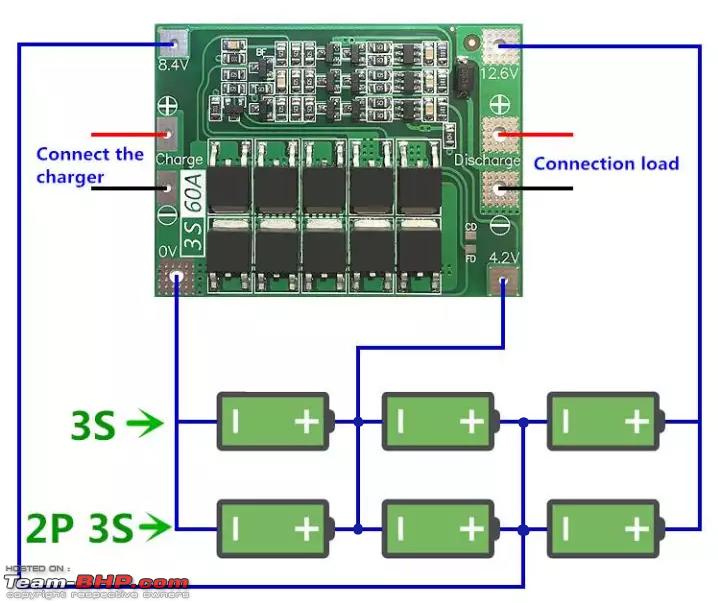 The 3S40A BMS module is the same one that we used in an earlier DIY project as well and touchwood, that too is performing exactly as intended. Hence, we can absolutely vouch for this 3S40A BMS. This BMS is available on websites like Robu, Amazon, Quartz Components, ElectronicsComp.com, etc as well as in local shops. Earlier, we had purchased this BMS from Robu but this time we got it from a local shop here in Kolkata. Quote:
As I mentioned to our fellow Bhpians clevermax and bobbyblr above, balancing of the cells is absolutely essential for Lithium cells which you mentioned as well. My son already chose the best-refurbished cells and the balancing aspect is being taken care of by the BMS which has a balancing functionality as well. I hope that I was able to assuage all of your very valid concerns. However, please feel free to ask/share more if necessary  Last edited by Chhanda Das : 24th March 2023 at 16:34. | |||
| |  (8)
Thanks (8)
Thanks
|
| The following 8 BHPians Thank Chhanda Das for this useful post: | AJ56, bobbyblr, Boo, GTO, PowerSpike, theexperthand, viXit, Voodooblaster |
| | #7 |
| BHPian | Re: DIY: Making a DIY 12v Lithium-Ion battery at home Nice DIY. I have two questions. How did you manage to procure the exact BMS required for the battery pack ? How did the dead cells started working again ? |
| |  (2)
Thanks (2)
Thanks
|
| The following 2 BHPians Thank edunata for this useful post: | Chhanda Das, d.w.w. |
| | #8 | |
| BHPian Join Date: Jan 2023 Location: KL
Posts: 90
Thanked: 1,027 Times
| Re: DIY: Making a DIY 12v Lithium-Ion battery at home
I had the same question too, so I checked out the other thread mentioned and found this. Quote:
| |
| |  (2)
Thanks (2)
Thanks
|
| The following 2 BHPians Thank d.w.w. for this useful post: | Chhanda Das, edunata |
| | #9 |
| BHPian Join Date: Aug 2014 Location: Mumbai
Posts: 290
Thanked: 651 Times
| Re: DIY: Making a DIY 12v Lithium-Ion battery at home Very nice DIY. Just a question - would the cardboard packing inside the box be a fire hazard, since paper/cardboards catch fire easily. Does the BMS check temperature also & throws some alerts? Any other way to keep track of temperatures & throw alerts, especially since Li battery fires would be almost impossible to douse. |
| |  (1)
Thanks (1)
Thanks
|
| The following BHPian Thanks aashishnb for this useful post: | Chhanda Das |
| | #10 | ||
| BHPian Join Date: Jun 2019 Location: Kolkata
Posts: 395
Thanked: 2,855 Times
| Re: DIY: Making a DIY 12v Lithium-Ion battery at home Quote:
For making Lithium battery packs like this, the cell configuration (for example 1S, 2S, 3S, 4S, etc) and the maximum charge/discharge rate of the battery pack are the primary criteria for choosing a BMS. As a general rule of thumb, one can also use the Ah rating of the battery pack as a criterion for choosing the BMS. The maximum current rating of the BMS has to exceed the maximum Ah rating of the battery pack. In our case, my son could have gone for a 20 ampere-rated 3S BMS since the battery pack was going to be a 17.05 Ah one. However, he chose a 40 ampere-rated 3S BMS to have the scope for capacity additions in the future if necessary. BMS boards are easily available both online and in local shops. Earlier, I had purchased it online from Robu but this time I got it for my son from a local shop here in Kolkata. The shop is located on the third floor of the Naba Bharat building in the Chandni Chowk area of Kolkata if you are interested. They deal in a very wide variety of printed circuit boards. About your second question, the dead cells were always discarded. During the initial days of the earlier 12v 25 Ah Lithium battery-making project, we tried some very risky techniques like inserting a fine pin into the vents below the positive terminals of the cells to release the trapped gases and/or lightly hammering on the positive terminals themselves but those never worked for us. I hope this helps  Quote:
Under normal circumstances, most cardboard packing materials are indeed fire hazards but this situation is a bit different. Firstly, let us talk about the construction of 18650 model Lithium cells. These cells are constructed in such a way that when the cells overheat beyond a limit then they release a tiny bit of gas which instantly pushes away the positive end of the cell. Basically, the cell splits into two on the inside and hence dies immediately. Then there is an insulating plastic wrapper on the outside of each cell. Finally, my son covered the entire battery pack with adhesive polyimide tape which is known to be fireproof upto around the 260 degrees centigrade mark. Moreover, the BMS would cut the power to the row of the affected cell after sensing a voltage imbalance way before a cell catches on fire. In summary, what I am trying to say is that by the time a cell catches fire, the presence/absence of cardboard materials would already have become irrelevant. Moreover, a 18650 Lithium cell catching on fire would definitely fall in the rarest of the rare categories if we stick to the recommended standard charging/discharging rate. The BMS that my son used does not check the temperature or throw any alerts since this is a passive BMS that solely relies on voltage sensing. From what we experienced with this battery and the earlier one, these do not even get warm to the touch as long as we stick to the standard charging/discharging limits religiously. However, if you want an added layer of safety based on the temperature, then you can definitely go for an expensive active BMS with temperature-sensing functionality and Bluetooth/WiFi connectivity. A much cheaper but equally effective alternative would be to add either a 20 ampere or a 40 ampere 12v inline microcontroller-based digital temperature controller aka thermostat switch in conjuction with a relay to the passive BMS that we used. I hope this helps  | ||
| |  (6)
Thanks (6)
Thanks
|
| The following 6 BHPians Thank Chhanda Das for this useful post: | athalaga, bikertillidie, Boo, edunata, GTO, PowerSpike |
 |




